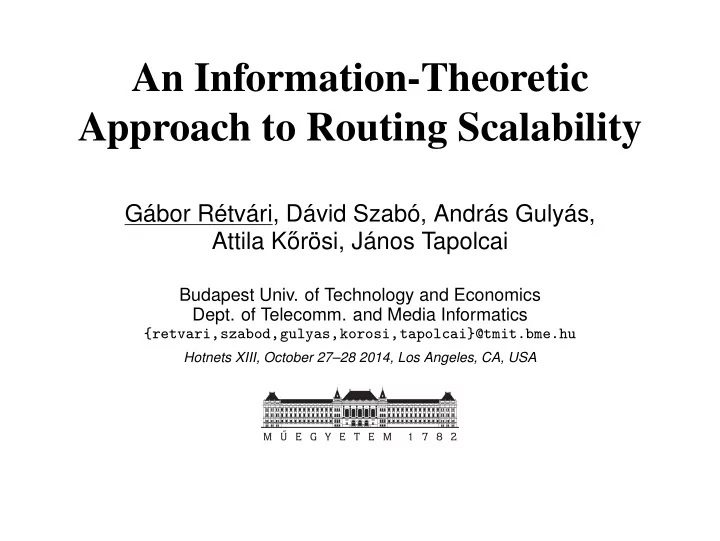

An Information-Theoretic Approach to Routing Scalability Gábor Rétvári, Dávid Szabó, András Gulyás, Attila K˝ orösi, János Tapolcai Budapest Univ. of Technology and Economics Dept. of Telecomm. and Media Informatics {retvari,szabod,gulyas,korosi,tapolcai}@tmit.bme.hu Hotnets XIII, October 27–28 2014, Los Angeles, CA, USA
The mysterious compressibility of IP forwarding tables • Take the IPv4 forwarding table of some Internet router • orders next-hops to address prefixes • Represent each distinct next-hop with a unique label • Take individual IPv4 addresses and write down the corresponding next-hop labels one by one • result is a string of 2 32 = 4 G symbols • naive representation of our forwarding table • Compress this string
The mysterious compressibility of IP forwarding tables Dest. IP Address Next-hop IP address Next-hop label blackhole 0 0.0.0.0 blackhole 0 0.0.0.1 . . . . . . . . . 17 80.92.12.254 149.11.10.9 17 80.92.12.255 149.11.10.9 18 80.92.13.0 213.248.79.185 . . . . . . . . . 41 152.66.244.111 195.111.97.83 41 152.66.244.112 195.111.97.83 41 152.66.244.113 195.111.97.83 . . . . . . . . . blackhole 0 255.255.255.255
The mysterious compressibility of IP forwarding tables 0 0 17 17 18 41 41 41 0 . . . . . . . . . • For a real router in the HBONE ( AS1955 ) $ fib2str hbone.fib.dump > hbone.bin $ ls − hs hbone.bin 4.0G hbone.bin $ bzip2 hbone.bin $ ls − hs hbone.bin.bz2 ???
The mysterious compressibility of IP forwarding tables 0 0 17 17 18 41 41 41 0 . . . . . . . . . • For a real router in the HBONE ( AS1955 ) $ fib2str hbone.fib.dump > hbone.bin $ ls − hs hbone.bin 4.0G hbone.bin $ bzip2 hbone.bin $ ls − hs hbone.bin.bz2 ??? • The compressed size is 116 Kbytes • That’s over 37 , 000 -fold reduction!!
Does hop-by-hop routing scale? • The key to data plane scalability is forwarding tables • involved in every packet lookup • routed address space is growing rapidly • Can we model forwarding tables and reason about size? Taken from the Internet Routing Entropy Monitor , see http://lendulet.tmit.bme.hu/fib_comp
The model • Graph of n nodes • No address space structure: each node has a random id • Routing policy (arbitrary) orders each destination node to an outgoing port • Forwarding table at node v is a string s v , so that the entry at position u is the next-hop port towards u 3 11 2 3 4 4 s 1 = < − , 1 , 2 , 2 , 2 > 2 1 1 8 2 1 5 3
Modeling power • How much information must be stored at a node to guarantee correct (as of the routing policy) forwarding? • We can use s v to answer this question • Theorem: if node ids are assigned randomly, any routing scheme must store at least nH 0 ( v ) bits at any node v , where H 0 ( v ) is the Shannon-entropy of the next-hop distribution in s v • nH 0 ( v ) bits is attainable, subject to a small error term, with very fast random access [Ferragina et al., SODA’07] • Routing scalability depends in H 0 ( v ) !
Analysis • Shortest path routing over the complete graph K n • Bad news: uniform link weights induce maximal forwarding table entropy: H 0 ( v ) = lg( n ) → n ∞ bits • Good news: random i.i.d. link weights induce constant forwarding table entropy: E ( H 0 ( v )) = lg e ≈ 1 . 44 bits • It seems that heterogeneity is the key to routing scalability, either topology-wise or policy-wise
Simulations • CAIDA AS-level Internet graph with inferred AS-AS business relationships • Valley-free routing with Gao-Rexford conditions • Ties broken by shortest AS-path length • Obtain the per-IP-prefix forwarding table for each AS • Result is a string of ∼ 500 , 000 entries • Calculate entropy
Validation • Downloaded IPv4 forwarding tables from two ASes • Internet2 (AS11537): couple of thousand prefixes • Reality: H 0 = 1 . 3 . . . 1 . 7 bits • Simulations: H 0 = 1 . 72 bits • HBONE (AS1955): full-BGP tables with > 500 , 000 prefixes • Reality: H 0 = 1 . 28 bits • Simulations: H 0 = 1 . 26 bits • Such a precision is at least suspicious
The Internet scalability map
Discussion • Forwarding table entropy is surprisingly low • below 1 bit at 99 % of ASes • results 50 – 70 Kbytes forwarding tables at lower tiers • about half a megabyte at the Tier 1 • 10 million IP prefixes would still yield only 10 Mbytes forwarding tables • And this is with disregarding address space structure! • Tier1 pays the price for Internet growth (in terms of entropy) • Regularity emerges somehow in large-scale forwarding tables
Acknowledgement • Thanks to Internet2 and HBONE for allowing access to their IP FIBs • Visit the the Internet Routing Entropy Monitor at http://lendulet.tmit.bme.hu/fib_comp for daily statistics • Please, contribute data!
Recommend
More recommend